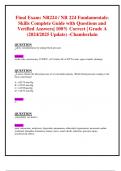Final Exam: NR224 / NR 224 Fundamentals: Skills Complete Guide with Questions and Verified Answers| 100% Correct | Grade A (2024/2025 Update ) -Chamberlain QUESTION safety considerations for taking blood pressure Answer: stroke side, mastectomy, IV/PICC, AV fistula, Hx of DVT in arm, open wounds, drainage QUESTION A nurse obtains the blood pressure of several adult patients. Which blood pressure reading is the most concerning? A. •102/70 mm Hg B. •125/85 mm Hg C. •145/95mm Hg D. •118/75 mm Hg Answer: C. QUESTION immobility can lead to Answer: joint contracture, atelectasis, hypostatic pneumonia, orthostatic hypotension, increased cardiac workload, thrombus formation, urinary stasis, renal calculi, infection, pressure injury, psychosocial effects QUESTION You notice a respiratory change in your immobilized postoperative patient. The change you note is most consistent with: A. atelectasis. B. hypertension. C. orthostatic hypotension. D. coagulation of blood. Answer: A. QUESTION acute care for immobile patient: metabolic/nutrition Answer: Provide high -protein, high -calorie diet with vitamin B and C supplements. QUESTION acute care for immobile patient: respiratory Answer: >Cough and deep breathe every 1 to 2 hours. >incentive Spirometer >Chest physiotherapy - percussion and positioning >Fluid intake QUESTION acute care for immobile client: CV Answer: >Reducing orthostatic hypotension >Reducing cardiac workload >Preventing thrombus formation >SCDs, thromboembolic disease (TED) hose, anticogulants >Early mobilization if possible >Isometric exercises QUESTION acute care for immobile client: musculoskeletal Answer: prevent muscle atrophy and joint contractures, physical therapy, ROM exercises, splinting QUESTION acute care for immobile client: skin Answer: reposition every 1 -2 hours, pressure relieving devices, skin care (dry but moisturized) QUESTION acute care for immobile client: bowels Answer: provide adequate hydration, diet high in fiber, fluids, fruits, veggies QUESTION factors influencing hygiene Answer: >Social practices >Personal preferences >Body image >Socioeconomic status >Health benefits and motivation >Cultural variables >Hospital policy - bath/shower every day QUESTION You are caring for a non -English -speaking male patient. When preparing to assist him with personal hygiene, you should: A. use soap and water on all types of skin. B. ensure that culture and ethnicity influence hygiene practices. C. shave facial hair to make the patient more comfortable. D. know that all patients need to be bathed daily. Answer: B. QUESTION Common diagnoses associated with hygiene Answer: >Activity Intolerance >impaired Dressing and Grooming >Impaired Mobility >Impaired Health Maintenance >Impaired Skin Integrity >Ineffective health maintenance >Risk for infection QUESTION A young girl with long hair is experiencing a problem with matting. The most appropriate action to take would be: A. cutting the matted hair away. B. braiding the hair to reduce tangles. C. using a grease -type product to tame the hair. D. keeping the hair oil free by applying powder every morning. Answer: B. •Rationale: Braiding helps to avoid repeated tangles; however, patients need to unbraid hair periodically and comb it to ensure good hygiene.




